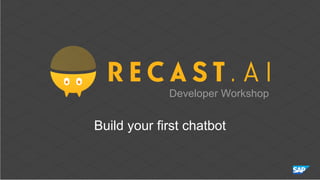Bot builder workshop
- 1. Developer Workshop Build your first chatbot
- 2. 1. Bots 2. Natural Language Processing 3. Conversation 4. Workshop 5. Resources
- 3. Bots
- 4. What is a bot? A bot is a program that automates a task. Users interact with it through messaging channels. The bots understand the request and perform an action.
- 5. Recast.AI Collaborative end-to-end bot platform BUILD CONNECT MONITORTRAIN Build conversation flow and powerful logic Train your bot to understand human language Connect your bot to multiple messaging or fallback channels Improve your bot by monitoring logs and usage analytics .
- 6. Bot architecture Logic Answers 2 3 Bot Connector Bot Builder API Backend
- 7. Get the userâs input Building Blocks of a Bot Understand what the user says Manage the conversation and understand context Improve the behavior by learning overtime Answer in a relevant way
- 9. Understanding input Natural Language Processing tasks Intent Classification Entity Extraction
- 10. Understanding input Natural Language Processing tasks I want a margherita pizza to be delivered at 5:00PM. Intent Classification Entity Extraction Intent: Order a pizza Pizza type: margherita Datetime: 5:00PM July 11th 2018
- 11. A bot is made of intents An intent is a set of expressions that mean the same thing but are constructed in different ways. Each one of your intents represents an action your bot is able to understand.
- 12. Every intent is trained with expressions An expression is a sentence your bot can understand: basically your usersâ inputs. Expressions are organized in intents and constitute the entire knowledge of your bot.
- 13. discover-movie INTENT I want to watch a movie Any good western tonight? I want to start a new show! greetings weather The more expressions you have, the more precisely your bot will be able to understand its users. The aim is to detect in which intent box an expression the bot has never seen is.
- 14. Entities are extracted from each expression An entity is a keyword extracted from an expression. We detect automatically 31 different entities such as datetimes, names, locations, etc.
- 15. Entities with a black star next to them are called Gold entities. They are automatically detected and extracted. But you are not limited to these Gold entities: you can also tag your own custom entities to detect keywords depending on your bot's context, such as movie genres if you are building a movie bot.
- 16. Conversation
- 17. A bot conversation is made of Skills. A skill defines a specific block of conversation that has a clear purpose. A skill can be as simple as the ability to greet someone, but it can also be more complex, for example giving movie suggestions based on information provided by the user. Skills definition Conversation made using Skills
- 18. E-commerce example Conversation made using Skills E-commerce An E-commerce chatbot could have 3 Skills such as: product search, order tracking and small talk.
- 19. Here is an example of a conversation with an E- commerce chatbot to track an order. E-commerce example Example of conversation
- 20. Closely linked to the core purpose of your bot Business Small talk and non- core related questions Floating Will be triggered automatically if no other skills is Fallback Skills type There are 3 different types of skills
- 21. Triggers Conditions determining if the skill should or shouldn't be activated Requirements Determining the information the bot needs to retrieve from the user, and how to retrieve it Actions performed by the bot when all requirements are complete (for example, send a message) Skill logic It is composed of three distinct parts
- 22. Skills have conditions Conditions define tests that will either be true or false. You will find conditions in different parts of your skill: triggers, requirements and in each message group in actions.
- 23. Conditions have operands Inside your data conditions, you will find a list of operands. @ means intent # means entity _ means NLP attribute
- 24. Entities SkillsIntents To summarise a bot is made of intents that are made of expressions that contain entities. Intents and entities are used by Skills to manage conversation
- 25. Workshop
- 26. Fork bot on Recast.AI: https://recast.ai/sanjana-reddy/movie-bot-skills-training/ Clone github repo: https://github.com/plieb/movie-bot-skills-training Install Ngrok: https://ngrok.com/ Follow tutorial: https://recast.ai/blog/nodejs-chatbot-movie-bot/
- 27. Resources



























